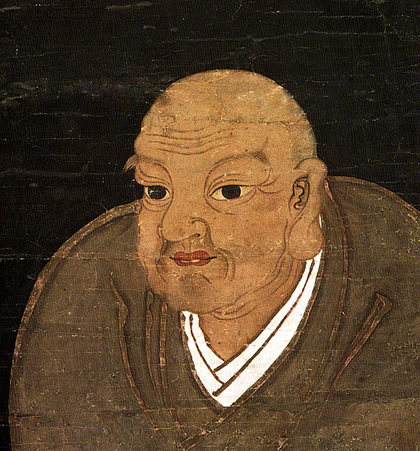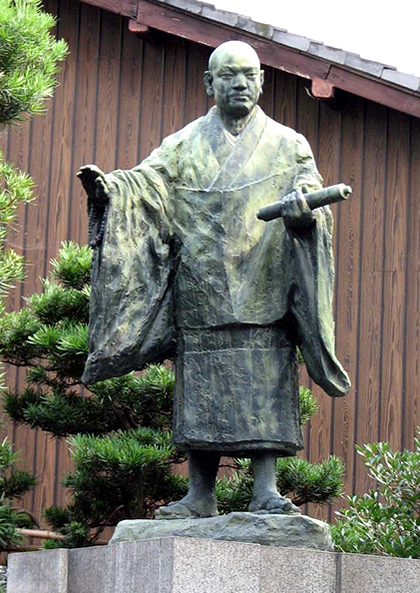World History
Nicheren (or Nichiren) Buddhism was a sect unique to Japan that challenged the existing notions of Buddhism as part of a societywide upheaval of intellectual and religious understanding.
The essence of Nicheren Buddhism is the reversal of the original message of Gautama Buddha, which Nicheren considered to have been used to exalt and protect the state to the detriment of individuals. Instead, people should study ways of achieving material and physical security and ease by following the Lotus Sutra (Saddharmapundarika-sutra).
Nicheren (originally Zennichi and also known as Zenshobo Rencho) was the son of a poor fisherman from the Awa province. He studied various forms of Buddhism over a 10-year period before concluding that all were false or otherwise unhelpful.
This was a period of Japanese history that was characterized by considerable turmoil. The huge distance between the court and the people was crumbling, and the intellectual landscape was threatened by social change and by external threats, notably the Mongol conquests.
Religious reformers traveled from the court to try to learn from the common people, who were almost completely alien to them. Radical schools of thought were widespread across the land and were represented by monks and scholars including Chomei, Jien, Honen, and Shinran.
The latter two were largely responsible for the spread of Amidist Buddhism, which abandoned all hope in the present world, which was doomed. Only faith in a future act of transcendence or salvation was of any value.
In response orthodox Buddhists sought to reinstate traditional monkish asceticism and reliance on good works. Nicheren ultimately rejected both Amidism and the orthodox Buddhist response as being inadequate to respond to the world as it stood, particularly the very real possibility of Mongol invasion, which threatened the existence of the Japanese culture altogether.
He believed that Japan was suffering the period of the degradation of the law of dharma known as mappo and that he was the embodiment of the bodhisattva Jogyo, whose task was to rescue his people and nation during their time of tribulation.
He came to believe that this could be accomplished through recognizing the threefold nature of the Lotus Sutra, which was the culmination of Sakyamuni Buddha’s final teaching and that Sakyamuni was to be identified with the eternal Buddha. This was composed of the dharma-kaya (the universal body), the sambhogakaya (enjoyment body), and the nirmana-kaya (phenomenal body).
This gave rise to three great secret laws that Nicheren taught were the honzon, which focused on the ritual drawing of the Lotus Sutra, the daimoku, which featured ritual chanting of the name of the Sutra, and the kaidan, which was related to the place of ordination.
Only by following these teachings, according to Nicheren, would Japanese people and society develop sufficient strength and the power to resist the troublesome times afflicting them. This is considered to be the opposite of Buddhism, which preaches the need to escape from the physical world of suffering by relinquishing desire in all its forms.
Nicheren selected six disciples to continue his work after his death but they were unable to prevent the multiplication of sects associated with his teaching. In the modern world, nearly 40 million Japanese profess beliefs that derive from Nicheren’s teachings, which have had considerable importance in shaping the spiritual and intellectual nature of Japanese society. Nevertheless, his standing remains controversial.
- Honen Shonin (honen Bo Genku)
Honen Shonin (Honen Bo Genku)A Japanese Buddhist philosopher and the founder of the Jodo Shu (Pure Land Buddhism), Honen Shonin was born in the Mimasaka province on the southern part of Honshu Island, Japan. His father, Uruma Tokikumi, was a provincial...
- Nara
Nara - Todai temple Nara is a city and prefecture in central, inland Japan that acted as the capital between 710 and 784. Prior to the Nara period, the capital of Japan was moved from city to city at the behest of an incoming emperor. However the accession...
- Shotoku Taishi
Prince Shotoku Taishi Prince Shotoku Taishi was crown prince and regent of Japan between 592 and 622. His rule opened an era of great reforms that advanced Buddhism and Chinese political and cultural influence in Japan. For his role he is called the Great...
- Zen (ch’an) Buddhism
Zen (Ch’an) BuddhismZen is a form of Buddhism that concentrates on calm, reflective forms of meditation in the quest for enlightenment. The word Zen, by which the school is known in Japan, derives from the Sanskrit word dhyana, which means “meditation.â€...
- Buddha: 350 Years Old Yields Interesting Documentss
Documents inserted into the mouth of this 1662 Buddha shortly after it was carved are part of the Lotus Sutra, according to this interesting Washington Post story about the results of an X-ray and endoscopy of the statute. Click on the story and you can...
World History
Nicheren - Religious Leader
 |
| Nicheren - Religious Leader |
Nicheren (or Nichiren) Buddhism was a sect unique to Japan that challenged the existing notions of Buddhism as part of a societywide upheaval of intellectual and religious understanding.
The essence of Nicheren Buddhism is the reversal of the original message of Gautama Buddha, which Nicheren considered to have been used to exalt and protect the state to the detriment of individuals. Instead, people should study ways of achieving material and physical security and ease by following the Lotus Sutra (Saddharmapundarika-sutra).
Nicheren (originally Zennichi and also known as Zenshobo Rencho) was the son of a poor fisherman from the Awa province. He studied various forms of Buddhism over a 10-year period before concluding that all were false or otherwise unhelpful.
  |   |
This was a period of Japanese history that was characterized by considerable turmoil. The huge distance between the court and the people was crumbling, and the intellectual landscape was threatened by social change and by external threats, notably the Mongol conquests.
Religious reformers traveled from the court to try to learn from the common people, who were almost completely alien to them. Radical schools of thought were widespread across the land and were represented by monks and scholars including Chomei, Jien, Honen, and Shinran.
The latter two were largely responsible for the spread of Amidist Buddhism, which abandoned all hope in the present world, which was doomed. Only faith in a future act of transcendence or salvation was of any value.
In response orthodox Buddhists sought to reinstate traditional monkish asceticism and reliance on good works. Nicheren ultimately rejected both Amidism and the orthodox Buddhist response as being inadequate to respond to the world as it stood, particularly the very real possibility of Mongol invasion, which threatened the existence of the Japanese culture altogether.
He believed that Japan was suffering the period of the degradation of the law of dharma known as mappo and that he was the embodiment of the bodhisattva Jogyo, whose task was to rescue his people and nation during their time of tribulation.
He came to believe that this could be accomplished through recognizing the threefold nature of the Lotus Sutra, which was the culmination of Sakyamuni Buddha’s final teaching and that Sakyamuni was to be identified with the eternal Buddha. This was composed of the dharma-kaya (the universal body), the sambhogakaya (enjoyment body), and the nirmana-kaya (phenomenal body).
 |
| Nicheren Statue |
This gave rise to three great secret laws that Nicheren taught were the honzon, which focused on the ritual drawing of the Lotus Sutra, the daimoku, which featured ritual chanting of the name of the Sutra, and the kaidan, which was related to the place of ordination.
Only by following these teachings, according to Nicheren, would Japanese people and society develop sufficient strength and the power to resist the troublesome times afflicting them. This is considered to be the opposite of Buddhism, which preaches the need to escape from the physical world of suffering by relinquishing desire in all its forms.
Nicheren selected six disciples to continue his work after his death but they were unable to prevent the multiplication of sects associated with his teaching. In the modern world, nearly 40 million Japanese profess beliefs that derive from Nicheren’s teachings, which have had considerable importance in shaping the spiritual and intellectual nature of Japanese society. Nevertheless, his standing remains controversial.
- Honen Shonin (honen Bo Genku)
Honen Shonin (Honen Bo Genku)A Japanese Buddhist philosopher and the founder of the Jodo Shu (Pure Land Buddhism), Honen Shonin was born in the Mimasaka province on the southern part of Honshu Island, Japan. His father, Uruma Tokikumi, was a provincial...
- Nara
Nara - Todai temple Nara is a city and prefecture in central, inland Japan that acted as the capital between 710 and 784. Prior to the Nara period, the capital of Japan was moved from city to city at the behest of an incoming emperor. However the accession...
- Shotoku Taishi
Prince Shotoku Taishi Prince Shotoku Taishi was crown prince and regent of Japan between 592 and 622. His rule opened an era of great reforms that advanced Buddhism and Chinese political and cultural influence in Japan. For his role he is called the Great...
- Zen (ch’an) Buddhism
Zen (Ch’an) BuddhismZen is a form of Buddhism that concentrates on calm, reflective forms of meditation in the quest for enlightenment. The word Zen, by which the school is known in Japan, derives from the Sanskrit word dhyana, which means “meditation.â€...
- Buddha: 350 Years Old Yields Interesting Documentss
Documents inserted into the mouth of this 1662 Buddha shortly after it was carved are part of the Lotus Sutra, according to this interesting Washington Post story about the results of an X-ray and endoscopy of the statute. Click on the story and you can...
